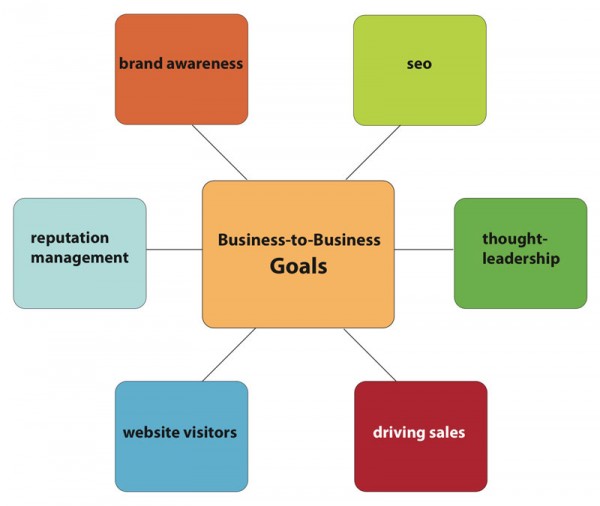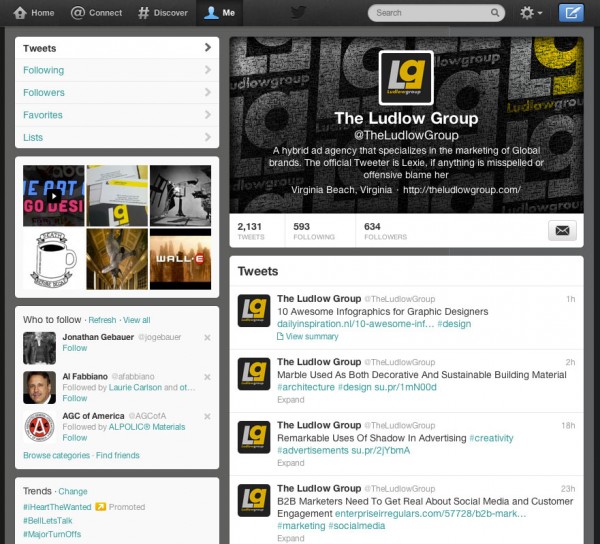Beneficial Social Media Tools In The Business To Business Market
Here at the Ludlow Group the majority of our clients are in the construction products industry. As such, we specialize in print, interactive, and social media marketing within that industry in particular. The following article was written for an online design publication, please comment below with your thoughts.
Despite your industry, every company can reap the benefits of social media marketing. While although inherently different for business to consumer, business to business companies of all sizes have found social tools useful in the advancement of their brands. Yet, there are certain outlets that are considered more advantageous, not only for B2B companies, but particularly for those companies in the construction products industry.

For the majority of B2B companies their goals consist of increasing brand awareness, customer loyalty/reputation management, organic search rankings, thought-leadership, organic traffic, and driving sales. It is critical to establish goals prior to engaging in social media. Even more crucial, is the need to have a properly optimized and functional website. Despite your presence on social outlets, visitors will always return to your company website to verify your legitimacy.
Your website is your home base. By home base I mean it is the place in which your customers will go to become potential leads. Your social outlets will refer back to your company website, giving you a centralized presence online.
I am not a proponent of “social real estate.” Social real estate is a theory amongst social media marketers in which they believe it is beneficial to join as many social outlets as possible in hopes of covering the most online territory. While social engagement is often trial-and-error, it is most beneficial to first research where your audience is before starting any campaign.
Your audience includes your current customers and your potential prospects. Your audience may also include other industry professionals known as influencers, who may not be customers or prospects but have the ability to influence the views of members in your particular industry.
THE OUTLETS
Common outlets for business-to-business brands include e-newsletters, email marketing, video-sharing, social bookmarking, blogging, webinars, social networking sites, mobile applications, and forums. Often the most confusing outlets for B2B companies reside under the category of social networking. While social networking sites like Facebook and LinkedIn are fantastic business tools, it is important to think of social media strategically and not be seduced by popular mediums.
FACEBOOK
There is no doubt that Facebook is a dominating force in the world of social media. Yet, I do not believe Facebook is appropriate for every brand. Easily seduced by grandiose statistics, companies have several misconceptions about Facebook.
Facebook is entirely about engagement. It was originally created for individuals and then later catered for business use. The average Facebook user “likes” about 80 business pages. So while liking your company page, users also like large corporate entities such as Coca Cola, Lady Gaga, and Nike.
Businesses are under the false assumption that the number of “likes” equates to the number of users that will see their posts. Due to their internal algorithmic system, Facebook determines what percentage of your likers will actually see your company’s updates, which is on average about 16%. This number is based solely on engagement - clicks, likes, shares, comments, etc. – and not the number of times a user looks at your company page.
In the construction products industry it might be more beneficial to engage on networks that are more business oriented, such as LinkedIn.
LINKEDIN
LinkedIn is a fantastic resource for B2B companies. In numerous studies LinkedIn has been cited as one of the most popular outlet in the business-to-business marketplace for lead generation. There are two options for companies on LinkedIn, groups or pages. Groups are great for building thought leadership around specific industry topics. Pages allow companies to showcase products and services, engage with customers and prospects, post employment opportunities and share company news. LinkedIn also has targeting options that allow you to provide only the most relevant information to specific groups of followers.
TWITTER
Brands have found value in Twitter through customer service, brand awareness, news, understanding customer and competitive behaviors, extending reach, relationship building, driving traffic and networking. However, this is only after researching what their audience needs.

The most fundamental aspect of social media is ‘knowledge.’ People engage in these various networks to consume and repurpose knowledge to others. Success in Twitter is achieved by becoming useful to your audience. Every business can find some value in Twitter, regardless of whether your audience actively present or not.
Try to not be seduced by a popular medium. Often social media adoption is a matter of trial-and-error. Discover goals, find your audience, create a strategy, engage and then measure. If your goals are not achieved, then it is worth reevaluating your current strategy and finding new outlets to participate in.
